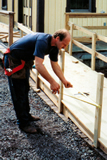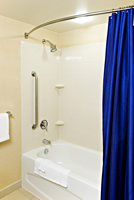Ways to Make the Home Safer

(Home Modification)
After a stroke, your loved one may fall or have trouble moving around. You can make changes to improve home safety. These types of changes are called “home modification.”
What Do You Need to Know?
Some changes are easy and you can do them yourself. For bigger changes, you may need professional help. The changes you make depend on the needs of your loved one.
What Can You Do?
Look around and find ways to make your home safe. Watch your loved one walk in the home to find areas that are unsafe.
Bathroom
- Buy non-slip bath mats, tub or shower benches and toilet chairs.
- Install handrails beside the toilet and in the tub or shower.
- Install a hand-held shower head so your loved one can sit during a shower.
Kitchen
- Buy a stove with controls in the front. Your loved one will be able to reach the controls when cooking.
- Lower counters to make them easier to reach while sitting.
- Keep oven mitts and heat-proof mats close to the stove. Leave areas near the stove clear to place hot dishes.
- Place a fire extinguisher in easy reach.
Bedroom
- Put bedrails on the bed for safety.
- Place a commode beside the bed so your loved one won’t need to walk to the bathroom. This can prevent falls at night.
What Changes Can Be Made for Stroke Survivors Who Use Wheelchairs?
Remove the cabinet under the stove or sink so your loved one can roll under. Use heat-proof covering (insulation) on pipes in roll-under sinks and stoves to prevent burns.
Stroke survivors may have trouble moving wheelchairs on heavy carpet. Use non-slip flooring if you remove the carpet. Widen doorways to help stroke survivors get in and out of the home. Outdoor and indoor ramps can also be built.
What Are Some General Home Changes?
Place pads on soft furniture to help with toileting accidents − Cover the pads so that other people will not notice.
Remove throw rugs − Use double-sided tape to hold down carpets.
Keep floors clear − Place large furniture far apart to help your loved one move around. Make sure furniture does not move if leaned on. Cover sharp corners of furniture.
Place handrails on both sides of stairs for safety − Elevators or lifts for the home can help stroke survivors who cannot climb stairs.
Replace door knobs and faucet knobs with lever handles − This will help stroke survivors who have trouble using their hands and arms.
What Are Some Other Safety Changes?
- Place a phone in each room or give your loved one a cell phone to call for help. Large-button phones are helpful for people who have trouble seeing.
- A medical alert system that the stroke survivor can carry may help.
- Lighting should be bright (use high wattage light bulbs) to prevent falls. Install overhead lights or nightlights in doorways, hallways and bathrooms.
- Install and regularly check smoke detectors and carbon monoxide detectors.
- Move all cords out of the way. Make sure cords are in good repair to prevent shock or fires.
Helpful Tips
- If possible, have your loved one visit the home before the last day in the hospital. Some hospitals and rehabilitation centers will let patients take weekend trips to visit family. This will help you learn how to make the house safe before your loved one comes home.
- Occupational therapists, visiting nurses and physical therapists can come to your house and help you make changes.
- Purchase items for home safety at medical equipment stores and through catalogs.
How Can You Pay for Home Modification?
Insurance and Medicaid
Some changes to the home may be covered by insurance. Talk to private insurance companies to see what can be covered. Medicaid may pay for some needed medical items.
Government Funding
The VA has some funding through its Home Loans program. Contact other government resources, such as the U.S. Department of Housing and Urban Development and the Social Security Administration to help with funding. You may also get information from Eldercare Locator. The Resources section has more information. Talk to the social worker at your hospital to find out more about all of these programs.
Private Funding
Non-profit and volunteer groups may pay for some home changes. Contact groups like Rebuilding Together and NeighborWorks Network. You can find their contact information in the Resources section.
Remember
- The needs of your loved one should determine the changes you make. The healthcare team can help you make the right changes.
- Home changes are often easy to make and you do not need a lot of money. Talk to a social worker if money is a problem. There are ways to obtain help in paying for home changes.
- Look around and keep checking your home for ways to make it safe.
More Resources 
Additional credible resources on this topic can be found here. Website pages may change or update, therefore if a link does not work, you may also try to type the information into your internet search bar. This Resource List will be updated frequently.
|
*Link Disclaimer: Links to information and Web sites outside of the Department of Veterans Affairs do not indicate an endorsement of products or services offered by the sites. In addition, these sites may have privacy and security policies that are inconsistent with those of VA. |
References: Sabata, D., Butler, L. (2007). Adapting the home after a stroke. Retrieved July 10, 2008, from, The Internet Stroke Center: http://www.strokecenter.org/patients/ot/index.htm*; Pereira, H.K. (2006). Home safety checklist. Retrieved July 10, 2008, from, Strength for Caring: http://www.strengthforcaring.com/daily-care/home-safety-modifications-home-safety/home-safety-checklist/*; La Grow, S.J., Robertson, M.C., Campbell, A.J., Clarke, G.A., & Kerse, N.M. (2006). Reducing hazard related falls in people 75 years and older with significant visual impairment: how did a successful program work?. Injury Prevention. 12, 296-301.
These materials were created for the project:
Web-Based Informational Materials for Caregivers of Veterans Post-Stroke
Project Number SDP 06-327 funded by VA HSR&D Quality Enhancement Research Initiative (QUERI)



















